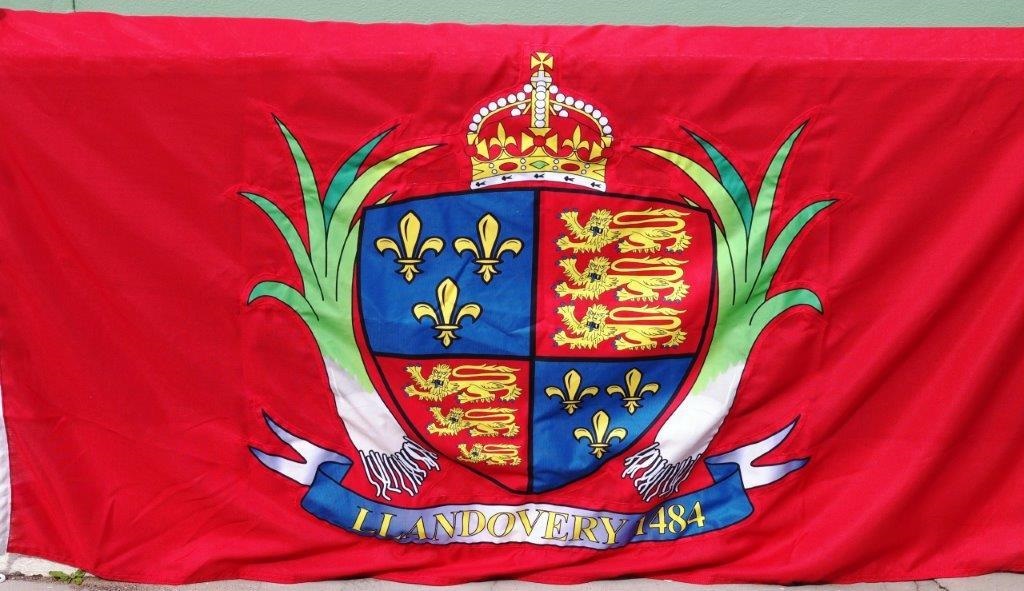Carmarthenshire town unfurls new flag as part of effort to promote its history

Richard Youle, local democracy reporter
A Carmarthenshire town which once had 70 pubs and a beer-drinking goat is reviving and promoting its history to tourists.
Llandovery is the home of vicar and poet Rhys Pritchard, hymn writer William Williams Pantycelyn, while an outlaw called Twm Sion Cati – described by some as a Welsh Robin Hood – used to hide in a cave north of the town.
The town council has just secured listed planning consent to fly the Llandovery crest on the town hall, Market Street.
A statement submitted as part of the flag-flying application said the main consideration was to promote Llandovery – or Llanymddyfri in Welsh – as a tourist venue and gateway town to the Cambrian Mountains.
Stephen Carter, the town council’s clerk, said a flag bearing the coat of arms was made two years ago, just before the Covid pandemic.
“It’s been in my cupboard ever since,” he said.
The flag-flying proposal was advertised in the town as part of a consultation, and the response from the public was positive.
That work is ongoing in other areas. A blue plaque has been installed commemorating William Williams Pantycelyn, whose most famous hymn – Arglwydd, arwain trwy’r anialwch (Lord, lead thou through the wilderness) – was translated as Guide Me, O Thou Great Redeemer. He died in 1791.
Another blue plaque commemorates the Black Ox Bank, or Banc yr Eidion Du, which was founded in 1799 in Llandovery and bought out by Lloyds Bank in 1909.
Llandovery was granted a royal charter in 1485 by Richard III and was a key staging post for the West Wales drovers who used to take their cattle to market in London.

“In the 19th Century there were 70 pubs in Llandovery,” said the mayor of the town, Cllr Handel Davies.
Some of them were visited by clergyman Rhys Pritchard (1579–1644) and his goat.
Cllr Davies said the story goes that the goat drank beer on its first tavern crawl but would not touch it the following evening, which inspired its owner’s poems on leading a virtuous life.
The town council is now keen to attach name plates to houses and buildings in Llandovery – with the owners’ permission – which bear the name of the tavern which once existed there.
And Cllr Davies, who is also a county councillor, said an interpretation board has been installed near the cave at Rhandirmwyn, north of Llandovery, where Thomas Jones – alias Twm Sion Cati – used to hide.
Much has been written about the 16th Century outlaw, farmer and poet, often focusing on his apparent Welsh Robin Hood attributes. But others say he deserves more respect.
A history website, rhandirmwyn.net, said it was possible he hid in the cave to avoid religious persecution rather than the anger of those tricked by him.
It said he “lived many lives” until his death in 1609, but added: “Many of the escapades attributed to him probably flowed from the imagination of various novelists.”
Support our Nation today
For the price of a cup of coffee a month you can help us create an independent, not-for-profit, national news service for the people of Wales, by the people of Wales.





Only welsh flags in wales 🏴 no English or English royals flags in wales 🏴 and no British flags in wales 🏴
Are you deciding for me what flag I can have. Is this the dictatorial Nationalist who will allow no freedom of thought. Whatever you think there are names on memorials in every village in Wales who fought for the Union flag. Read the newspaper letters of the time about their motives for joining the British army. People led by a great Welshman David Lloyd George. People who fought tyrany whose commitment to freedom is celebrated. I don’t think you you like that freedom of thought and expression.
Didn’t Jon Gower write a review here on Prichard’s Nose about T J Llewellyn Prichard? Anyone interested in Twm Sion Cati or this neck of the woods would enjoy Sam Adam’s book as they would Prichard’s early Anglo-Welsh novel “The Adventures and Vagaries of Twm Shon Catti, descriptive of Life in Wales” both of which are still in print.
I personally find the best thing about Llandovery is the Llywelyn ap Gruffydd statue by the Petersen brothers.
Twm Sion Cati is Twm Sion Cati, there is no need to describe him as the ‘Welsh Robin Hood’
Looks Anglo French with a side salad. Should have stayed in the cupboard.
The 3 lions? Was this the flag of Llewelyn Prince of Wales?
What a mess. I thought better of Sir Caerfyrddin. There’s celebrating regional Welsh history and embracing the symbolism of colonialism, be it English or Norman French. What next? Carmarthenshire marking St’ George’s Day. This is reminiscent of the recently Iron Ring monument suggested for NE Wales. The English three lions is most certainly not Welsh or is the Norman Fleur-De-Lis. I would have preferred either a Dragon rampant or the four lions that was a Welsh heraldry used in Wales by native princes and perhaps the mythological figure Myrddin (Merlin) being linked with Carmarthenshire. And yes, the Leek can be… Read more »
Very constructive argument here. I too thought the lions and fleur-De-Lis looked very odd for a cultural flag in Wales and the cultural significance of Merlin together with the daffodil would herald more significance around these parts.
The coat of arms is Richard III’s who granted Llanymddyfri it’s charter in 1484 (I presume). as an incentive to support him. The bribe didn’t do him much good as the locals followed Rhys ap Thomas to Bosworth and the rest as they say is history.
Not sure that drawing attention to the historic duplicity of the citizens of Llanymddyfri (admittedly in the right cause) is a particularly good move. Or maybe they’re not going to mention it.